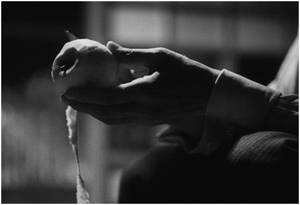Cannon of 250 Films - #244
www.a2pcinema.com/canon
244... GOYOKIN
1969 - Hideo Gosha - Japan
www.a2pcinema.com/canon/films/244.htm
Opening Shot
Being the first Japanese film made in Panavision, Goyokin utilizes it from the opening frame- a wide shot of a scenic mountainside followed by a series of shots with a voiceover giving a background intrduction to the story and setting.
The Film
I am including this film over my favorite Hideo Gosha film (Sword of the Beast) simply because I believe it is a more definitive work of both the filmmaker and of the samurai genre. Hideo Gosha is often overlooked as a great filmmaker but he is responsible for some notable films of Japanese cinema. His 7th feature, 1969’s Goyokin stands as a Japanese landmark simply because it was the countries first feature film shot in Panavision. Goyokin is a samurai film made very much in the conventions of the genre. These visuals are stunning throughout the film which uses landscapes of forests, villages, seasides, and colorful visuals to great heights. Gosha gives the film a complex depth and involvement through his crafty filmmaking. After a stunning opening sequence (a woman returning home to find her family slaughtered- intercut with shots of black crows), the film takes some time to develop but this is done mostly within the conventions of the genre. It builds tension through setup before quickly flashing the lively fight sequences. The layers of the story really evolve as the film progresses, centering on a samurai (Magobei) who choose to abandon his clan after they slaughter a small village in order to collect gold and pay taxes. Looking to rid the guilt Magobei protects the remaining survivor of the massacre and seeks to stop the clan from repeating the massacre. At the core is the trademark Gosha theme of rebellion, as well as that what drives all samurai films or characters: the Bushido code (a reality that can often be a burden). Tatsuya Nakadai gives a strong lead performance as the conflicted samurai and Ruriko Asaoka is also solid in the role of the woman he protects. Maybe not a masterpiece, Goyokin is top-notch samurai filmmaking with some serious emotional layers and crafty filmmaking. It has plenty of swordfights, but is far from bloodfest more common of samurai films. Still this remains a really good film from a talented filmmaker. I still prefer Gosha’s 1965 film Sword of the Beast, but Goyokin is among the better samurai films I’ve seen and is essential viewing for fans of the genre.
The Filmmaker
Hideo Gosha may not be in the class of the great masters of Japanese cinema, yet he remains overlooked as a significant filmmaker. Gosha is most notable as one of the essential filmmakers of the samurai genre. His films live within the conventions of the Japanese samurai genre. The samurai film thrived in Japanese cinema during the 50s and 60s varying in all different types. Gosha way not have been the innovator, but he was able to define the samurai in all it's varieties. Gosha did have a vision, and was a great craftsman as a filmmaker. His visual style is often compared to that of the Sam Peckinpah, a filmmaker mostly known for his innovative westerns. He particularity excelled staging action sequences within the layered emotions of the film. Gosha mostly stayed within conventions, but he thrived with these conventions and in turn made some of the most recognizable examples of the samurai genre: Three Outlaw Samurai (1964), Sword of the Beast (1965), Samurai Wolf 1 and 2 (1966/7), Goyokin (1969), and his most celebrated film Hitokiri (1969). Gosha went on to make other films (including yakuza films as well as the popular melodrama The Life of Hanako Kiruin (1982).



0 Comments:
Post a Comment
Subscribe to Post Comments [Atom]
<< Home